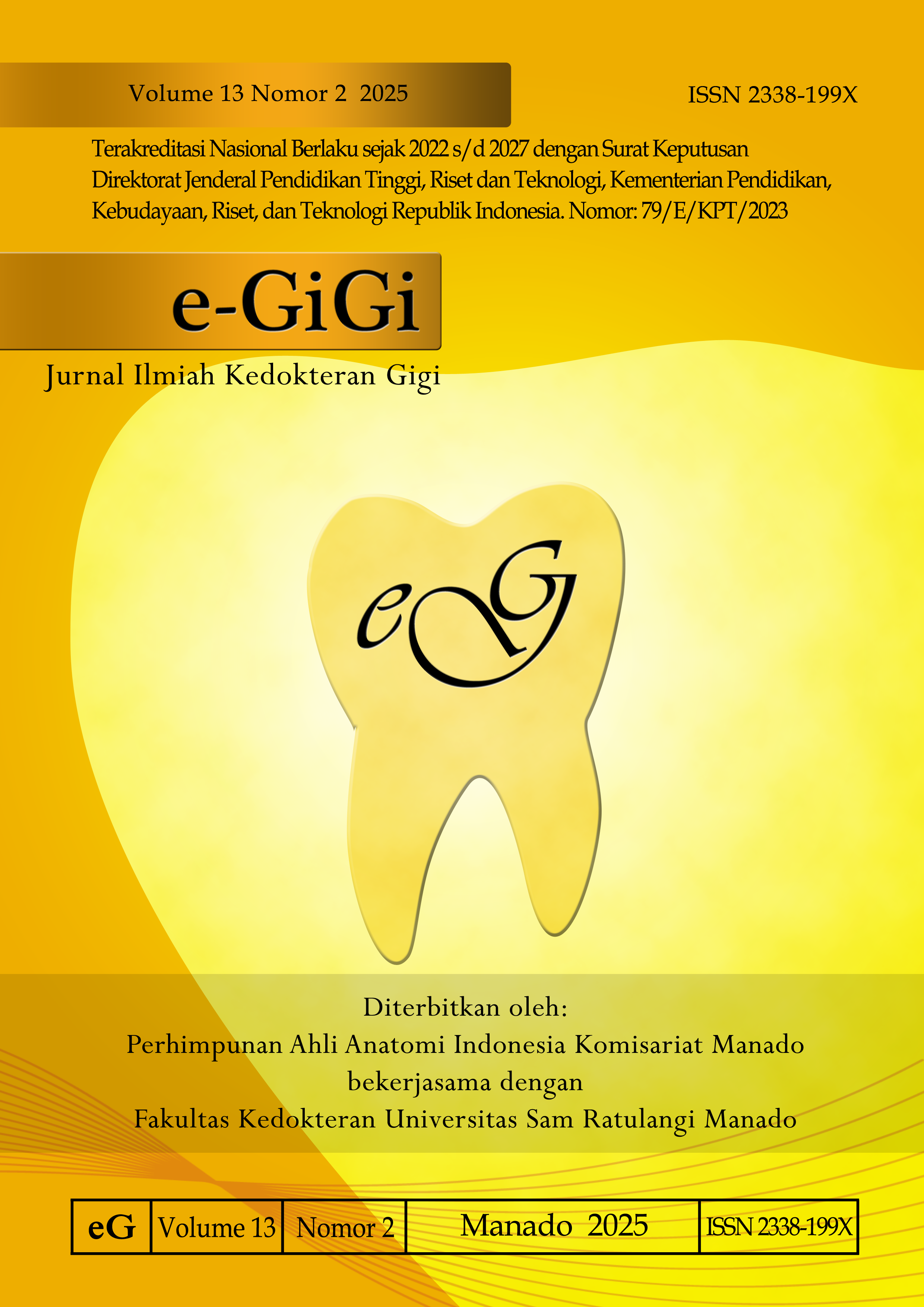Perbedaan Efektivitas Pendidikan Kesehatan Gigi Menggunakan Media Ular Tangga dan Busybook terhadap Pengetahuan Kesehatan Gigi Anak
DOI:
https://doi.org/10.35790/eg.v13i2.60189Abstract
Abstract: Around 3.5 billion people worldwide face dental health problems, primarily due to a lack of knowledge about the importance of dental care. Therefore, dental health education, especially for children, is crucial. This study was conducted at GMIM Tateli Elementary School, Pineleng District, Minahasa Regency, North Sulawesi Province. The aim of this research was to determine the difference in the effectiveness of dental health education using Snakes and Ladders and Busybook media on children's dental health knowledge. This study employed a quasi-experimental method with a pretest and posttest design involving 32 children aged 6-8 years. The Wilcoxon and Mann-Whitney tests were used for analysis. The Wilcoxon test results for Snakes and Ladders and Busybook media showed a significance value of p = 0.001 (p < 0.05), indicating statistical significance. The Mann-Whitney test showed a significance value of p = 0.048 (p < 0.05), also indicating statistical significance. The conclusion of this study is that dental health education using Snakes and Ladders and Busybook media can improve elementary school children's dental health knowledge, with Snakes and Ladders being more effective than Busybook.
Keywords: dental health education; snakes and ladders; busybook
References
World Health Organisation. Follow-up to the political declaration of the third high-level meeting of the General Assembly on the prevention and control of non-communicable disease- Draft Global Strategy on Oral Health. [Internet]. 2022 [cited 2023 Oct 26]. Available from: https://iris.who.int/ bitstream/handle/10665/327119/B144(1)-en.pdf
World Health Organisation. Global oral health status report. [Internet]. 2022 [cited 2023 Oct 28]. Available from: https://www.who.int/team/noncommunicable-diseases/global-status-report-on-oral-health-2022/
Zulkaidah U, Arsad, Yulistina, Dirman R, Yasin SA. Pentingnya menjaga kesehatan gigi dan mulut di Kelurahan Batu Lappa Kabupaten Sidrap. Community Dev. 2023;4(2):4313–5. Doi: https: //doi.org/10.31004/cdj.v4i2.15738
Kemenkes RI. Laporan Riskesdas 2018 Kementrian Kesehatan Republik Indonesia Vol. 53 [Internet]. 2018 [cited 2023 Oct 24]. Available from: http://www.yankes.kemkes.go.id/assets/downloads/PMK No. 57 Tahun 2013 tentang PTRM.pdf.
Purnama T, Rasipin, Santoso B. Pengaruh pelatihan tedi’s behavior change model pada guru dan orang tua terhadap keterampilan menggosok gigi anak prasekolah. 2019;13:75–6. Doi: https://doi.org/10.36082/qjk.v13i2.80
Blum HL. Planning for Health, Development and Aplication of Social Changes Theory. New York: Human Sciences Press; 1974. p. 219.
Wright GZ, Kupietzky A. Behavior Management in Dentistry for Children (2nd ed). London: Wiley Blackwell; 2014. p. 13.
Harris N, Godoy F, Nathe Ch. Primary Preventive Dentistry (8th ed). British Library Cataloguing-in-Publication Data. Pearson; 2014. p. 150–3, 245–5.
Mahendra D, Jaya IMM, Lumban AMR. Buku Ajar Promosi Kesehatan. Jakarta: Program Studi Diploma Tiga Keperawatan Fakultas Vokasi UKI; 2019. p. 18–30.
Anwar AI. Ilmu Kesehatan Gigi Masyarakat Teori dan Praktik Penyuluhan. Jakarta: Penerbit Buku Kedokteran ECG; 2019. p. 28, 79.
Sitanaya RI, Lesmana H, Irayani S, Septa B. Simulasi permainan ular tangga sebagai media peningkatan pengetahuan kesehatan gigi dan mulut anak usia sekolah dasar. Media Kesehatan Gigi Politeknik Kesehatan Makassar. 2021;20(2):28–33. Doi: https://doi.org/10.32382/mkg.v20i2.2563
Prakarsi E, Karsono K, Dewi NK. Penggunaan media busybook untuk mengembangkan kemampuan mengenal pola pada anak usia 4-5 tahun. Kumara Cendekia. 2020;8(2):171. Doi: https://doi.org/ 10.20961/kc.v8i2
Salsa DT, Isnanto, Hidayati S. Pengetahuan pemeliharaan kesehatan gigi dan mulut sebelum dan sesudah penyuluhan menggunakan media ular tangga (studi pada siswa kelas IV SD Islam An-Nur Surabaya tahun 2022). Ilmu Keperawatan Gigi. 2022;3(2):262–71. Doi: https://doi.org/10.37160/jikg.v3i2
Husna N, Prasko. Efektivitas penyuluhan kesehatan gigi dengan menggunakan media busybook terhadap tingkat pengetahuan kesehatan gigi dan mulut. Kesehatan Gigi. 2019;6(2):14–8. Doi: https://doi.org/ 10.31983/jkg.v6i1.4408
Febriany M, Pamewa K, Arifin FA, Mattalitti SFO, Wijaya SZH. Perbedaan pengetahuan kesehatan gigi mulut sebelum dan sesudah penyuluhan flipchart dan permainan ular tangga. Sinnun Maxillofac. 2021;3(02):11–6. Doi: https://doi.org/10.33096/smj.v3i02.7
Azhari AR, Haryani W, Almujadi. The influence of busybook media on dental caries toward knowledge of dental caries in children elementary school. Journal Oral Health Care. 2021;9(1):33–42. Doi: http://dx.doi.org/10.29238
Liasari I, Priyambodo RA, Utari N, Aida WN. Peningkatan pengetahuan kesehatan gigi pada siswa sekolah dasar melalui penggunaan media busybook pendekatan menarik dalam pendidikan kesehatan gigi increasing dental health knowledge in elementary school. Media Kesehatan Gigi. 2023;22(1):1–7. Doi: https://doi.org/10.32382/mkg.v22i1.23
Murti T. Perkembangan fisik motorik dan perseptual serta implikasinya pada pembelajaran di sekolah dasar. Wahana Sekolah Dasar. 2018;26(1):21–8. Doi: http://dx.doi.org/10.17977/um035v26i12018p021
Suryana D. Pendidikan Anak Usia Dini Teori dan Praktik Pembelajaran. Jakarta: Kencana; 2021. p. 31–3.
Downloads
Published
How to Cite
Issue
Section
License
Copyright (c) 2025 Vonny N. S. Wowor, Dinar A. Wicaksono, Engilica Apridinda

This work is licensed under a Creative Commons Attribution-NonCommercial 4.0 International License.
COPYRIGHT
Authors who publish with this journal agree to the following terms:
Authors hold their copyright and grant this journal the privilege of first publication, with the work simultaneously licensed under a Creative Commons Attribution License that permits others to impart the work with an acknowledgment of the work's origin and initial publication by this journal.
Authors can enter into separate or additional contractual arrangements for the non-exclusive distribution of the journal's published version of the work (for example, post it to an institutional repository or publish it in a book), with an acknowledgment of its underlying publication in this journal.
Authors are permitted and encouraged to post their work online (for example, in institutional repositories or on their website) as it can lead to productive exchanges, as well as earlier and greater citation of the published work (See The Effect of Open Access).






